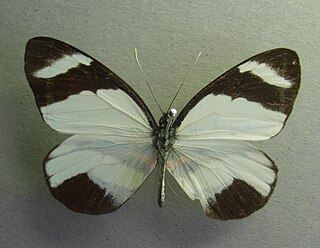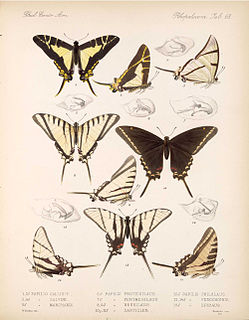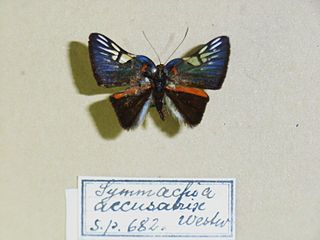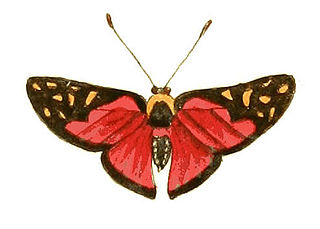| Symmachia calliste | |
|---|---|
 | |
| Figure 9, accepted as Symmachia calliste | |
| Scientific classification | |
| Kingdom: | Animalia |
| Phylum: | Arthropoda |
| Class: | Insecta |
| Order: | Lepidoptera |
| Family: | Riodinidae |
| Subfamily: | Riodininae |
| Genus: | Symmachia |
| Species: | S. calliste |
| Binomial name | |
| Symmachia calliste Hewitson, 1867 [1] | |
| Synonyms | |
| |
Symmachia calliste is a butterfly species of the family Riodinidae. It is present in Colombia, Brazil, Nicaragua and French Guiana.

Riodinidae is the family of metalmark butterflies. The common name "metalmarks" refers to the small metallic-looking spots commonly found on their wings. There are 1532 species and 146 genera of metalmark butterflies in the world. Although mostly neotropical in distribution, the family is represented both in the Nearctic and the Palearctic.

Colombia, officially the Republic of Colombia, is a sovereign state largely situated in the northwest of South America, with territories in Central America. Colombia shares a border to the northwest with Panama, to the east with Venezuela and Brazil and to the south with Ecuador and Peru. It shares its maritime limits with Costa Rica, Nicaragua, Honduras, Jamaica, Haiti, and the Dominican Republic. Colombia is a unitary, constitutional republic comprising thirty-two departments, with the capital in Bogota.

Brazil, officially the Federative Republic of Brazil, is the largest country in both South America and Latin America. At 8.5 million square kilometers and with over 208 million people, Brazil is the world's fifth-largest country by area and the fifth most populous. Brazil borders every South American country except Chile and Ecuador. Its capital is Brasília, and its most populated city is São Paulo. The federation is composed of the union of the 26 states, the Federal District, and the 5,570 municipalities. It is the largest country to have Portuguese as an official language and the only one in the Americas; it is also one of the most multicultural and ethnically diverse nations, due to over a century of mass immigration from around the world.












